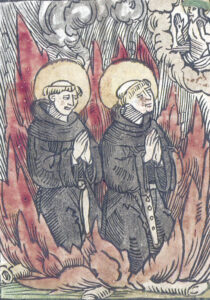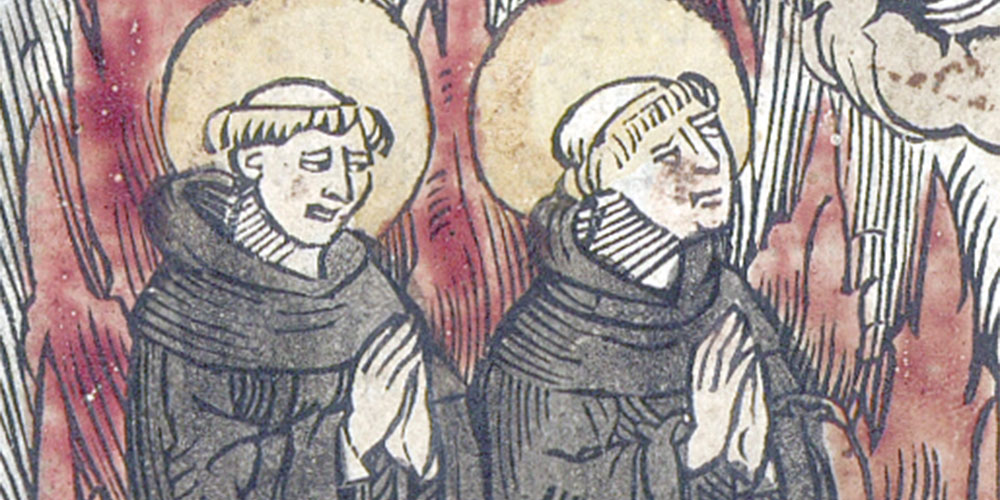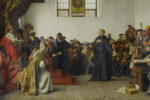 |
The first Lutheran martyrs confirmed that Luther’s doctrine was in fact Christ’s doctrine, worth dying for, and set a courageous example for all Christians who followed them.
Jesus once said, “Whoever loses their life for me and for the gospel will save it” (Mark 8:35). Apart from people in the Bible, can you name any Christians who have lost their lives for the sake of the good news of Jesus? Any Lutheran Christians?
Permit me to tell you the story of the first Lutheran martyrs, two men who were burned at the stake for their Lutheran faith five hundred years ago in the Grand Plaza of Brussels, Belgium, today a UNESCO World Heritage Site.
Persistent witness
The Augustinian monastery in Antwerp was founded in 1514 and seemed to have been sympathetic to the Lutheran Reformation from early on. By February 1522, one of the monastery’s priors had already been imprisoned for his Lutheran beliefs and persuaded to recant.
In July 1522, some monks from the same monastery were arrested for professing Lutheran teachings and then transported in wagons to the castle in Vilvoorde. More monks joined them in October, when the monastery was closed down.
At the castle, the monks were interrogated and pressured to recant. Most did, but three of them persisted—Hendrik Voes, Jan van den Esschen, and Lambert de Thoren. Hendrik and Jan appear to have been in their twenties. Jan was a charter member of the monastery. Lambert had been the prior of the monastery.
These three were taken to nearby Brussels for further questioning and judgment. A document listing 62 “Articles Asserted by Brother Hendrik and the Others” provided proof of heresy for the inquisitors and evidence of Lutheran doctrine for the three monks. The articles included these points:
- Neither the pope nor any other bishop is able to command or forbid something else that Sacred Scripture does not contain, or that God does not command or forbid.
- If a council should define something that is not contained in Sacred Scripture, it should be treated with suspicion.
- Baptism, the Eucharist [or Communion], and repentance rest on the promises of Christ, which kindle faith.
- The other four sacraments do not have a word of promise, but are rather anciently observed rites. Therefore they do not confer grace and [are] non-sacraments.
- The sacrament of the Eucharist is not a sacrifice on the altar; the sacrifice was only made once on the cross.
Seven men, most of them professors of theology at the University of Louvain, participated in the monks’ inquisition and condemnation.
Willing martyrdom
 In Brussels, the city council and the governor’s councilors concurred with the inquisition’s judgment. On July 1, 1523, at 11 A.M., the condemned men underwent the rite of degradation in the Grand Plaza. They were dressed up as priests and then denounced and defrocked in a public ceremony led by Adrien Aernoult, auxiliary bishop of Cambrai. At this point, Lambert yielded. He asked for a few days’ reprieve to reconsider his position. (Lambert ended up enduring a long and harsh imprisonment, dying in prison in September 1528.)
In Brussels, the city council and the governor’s councilors concurred with the inquisition’s judgment. On July 1, 1523, at 11 A.M., the condemned men underwent the rite of degradation in the Grand Plaza. They were dressed up as priests and then denounced and defrocked in a public ceremony led by Adrien Aernoult, auxiliary bishop of Cambrai. At this point, Lambert yielded. He asked for a few days’ reprieve to reconsider his position. (Lambert ended up enduring a long and harsh imprisonment, dying in prison in September 1528.)
After the degradation, four father confessors accompanied Hendrik and Jan to their pyres in the Grand Plaza, urging them to recant. When the priests began to cry at their refusal to do so, the monks told them to cry not for them but for their own sin.
Eyewitness accounts agree that the monks went to their deaths with extraordinary perseverance and resolve, and even with a degree of eagerness and cheerfulness. One eyewitness said that after they were stripped down to their undergarments, they seemed to embrace the stakes more than be tied to them. They repeatedly prayed, “Lord Jesus, Son of David, have mercy on us,” recited the Apostles’ Creed, and spoke or sang responsively the Te Deum (“We Praise You, O God”). One of them, as he looked down at the fire burning at his feet, said that roses seemed to be scattered beneath him. Finally, the heat and smoke inhalation choked out their voices, and their souls passed away to glory. The entire ordeal, from degradation to death, allegedly lasted nearly four hours.
Luther’s reaction
At the University of Wittenberg, word spread among the students that when Luther read the report about the two martyrs, he began to cry to himself and said, “I thought that I would certainly be the first to be martyred for the sake of this holy gospel, but I was not worthy of it.” Publicly, however, Luther expressed himself much more joyfully. He wrote to his friend Georg Spalatin on July 22 or 23, 1523, “Thanks be to Christ, who has finally begun to display some of the fruit of our message, or rather his message, and to create new martyrs, perhaps the first ever in that region” (WA Br 3:115).
At the end of July or beginning of August, he wrote a public letter of comfort and encouragement to “all dear brothers in Christ” in the Low Countries: “What joy, my dearest friends, you have not only taken part in, but have become its foremost partakers—a joy from which we ourselves have derived great joy and delight! For before all the world, you have been given the honor not only to hear the gospel and to acknowledge Christ, but also to be the first who now suffer shame and injury, apprehension and distress, imprisonment and danger for Christ’s sake, and have now matured into such ripe fruit and become so strong that you have also watered and confirmed it with your own blood” (WA 12:77–78).
Around the same time, Luther also composed his first hymn: a 12-stanza ballad about the martyrdom titled “A New Song Now Shall Be Begun.” The hymn’s favorable reception seems to have helped Luther realize music’s potential for instilling and spreading a worthy message.
Hendrik and Jan’s martyrdom proved that not only would people die confidently with the teachings of the Reformation but they also would die for them.
Courageous example
Hendrik and Jan’s martyrdom proved that not only would people die confidently with the teachings of the Reformation but they also would die for them. Such willingness is one of the proofs for whether a given doctrine is in harmony with the truth of the Scriptures. Jesus said that his gospel was worth our very lives and that the authorities and even church leaders would put some of his followers to death for it (Matthew 23:34, 24:9; Mark 8:35; Revelation 2:10). These martyrs confirmed that Luther’s doctrine was in fact Christ’s doctrine, worth dying for, and they set a courageous example for all Christians who followed them. More Lutherans, such as Heinrich von Zütphen and Georg Scherer, gave up their lives for the gospel in the following years.
We in the United States currently have religious freedom, which also means freedom from the risk of imprisonment and execution for our faith. This is not the case for Christians and Lutherans in other parts of the world. So if and while we have this freedom, let us enjoy it with profound gratitude to God. But let us also ask God to give us Hendrik and Jan’s willingness to forsake all, even life itself, rather than forsake what he has restored and handed down to us through reformers like Martin Luther—the pure teaching of Scripture, centered in the eternal gospel of our full and free salvation in Jesus.
Author: Nathaniel Biebert
Volume 110, Number 07
Issue: July 2023







